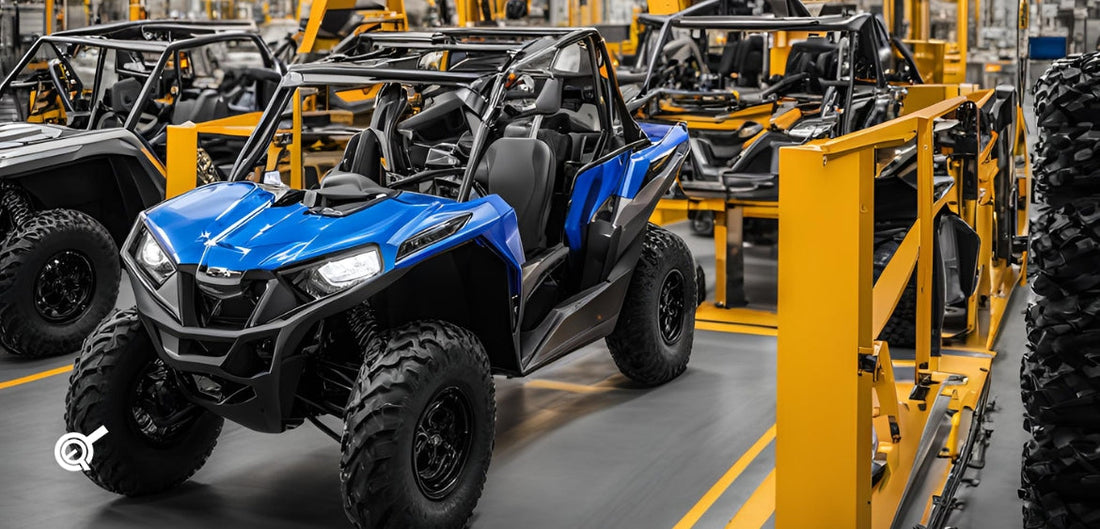In the ever-evolving world of automotive engineering, actuator technology advancements have emerged as a pivotal force in transforming the design and manufacturing processes of Utility Task Vehicles (UTVs) and All-Terrain Vehicles (ATVs). This revolution is driving significant improvements in user experience and reshaping industry practices, making UTVs and ATVs more efficient, reliable, and enjoyable for end-users.
In this article, we will investigate the technological advancements, manufacturing impacts, performance enhancements, and market trends that are currently shaping the future of UTV and ATV design.

Technological Advancements
Actuator Technology and Lightweight Materials
How can advanced actuator technology transform the way we drive UTVs and ATVs? One of the standout developments is the adoption of electric power steering, which offers precise control and reduces driver fatigue. This technology replaces traditional hydraulic systems, providing smoother and more responsive steering. The elimination of hydraulic fluid also reduces maintenance requirements and environmental impact.
The use of lightweight materials is another technological leap forward, and here is how they would change your approach to vehicle design. Materials such as carbon fiber and advanced composites are being employed to reduce the overall weight of UTVs and ATVs.

Carbon Fiber Composites
This weight reduction improves fuel efficiency, acceleration, and handling, making the vehicles more agile and responsive. Additionally, these materials are often stronger than traditional metals, increasing the durability and safety of the vehicles. Imagine a vehicle that is not only lighter but also stronger and more efficient.

Advanced High Strength Steel
Battery and Suspension Technologies
Another critical area of advancement is in battery technologies. The shift towards electric and hybrid models demands batteries that are not only more powerful but also more durable and efficient. Innovations in battery technology, such as solid-state batteries, are enabling longer ride times and quicker charging, addressing one of the main concerns of electric vehicle users. These advanced batteries are also safer, reducing the risk of overheating and fires.

Suspension technologies have also seen significant improvements. Modern suspensions are designed to provide better stability and comfort across varied terrains. Enhanced suspension systems, such as adaptive dampers, automatically adjust to changing road conditions, absorbing shocks more effectively. This leads to a smoother ride, reduces wear and tear on the vehicle, and improves overall handling.

Telematics Integration and Smart Control Systems
Telematics integration is revolutionizing the way UTV and ATV vehicles are monitored and managed. By incorporating telematics, manufacturers can provide real-time data on vehicle performance, location, and maintenance needs, thereby enhancing the user experience and extending the vehicle’s lifespan. Moreover, fleet managers can monitor the status of multiple vehicles remotely, optimizing usage and maintenance schedules to reduce downtime and costs.
Finally, smart control systems are bringing a new level of automation and user customization to UTVs and ATVs. These systems allow for automated adjustments to be made in response to driving conditions, providing an optimized driving experience and ensuring the highest levels of performance and safety. Features such as electronic stability control, traction control, and customizable driving modes are becoming standard, offering drivers better control and increased safety.

Impact on Manufacturing Processes
The advancements in actuator technology and other associated technologies are not only enhancing the vehicles themselves but are also revolutionizing the manufacturing processes. Precision engineering is at the heart of these advancements, allowing for the production of more reliable and high-quality components. Advanced machining techniques and computer-aided design (CAD) ensure that parts are manufactured to exact specifications, reducing the likelihood of defects and improving overall product quality.
Automation Technologies
Automation in manufacturing is becoming increasingly common, driven by the need for efficiency and consistency. Robotic systems and automated production lines are enabling manufacturers to produce vehicles faster and with greater accuracy, reducing human error and production costs. Robots can perform repetitive tasks with high precision, such as welding, painting, and assembly, ensuring consistent quality across all units.

At Progressive Automations, we manufacture high-force electromechanical actuators designed for a wide range of applications for automotive factory automation, such as robotic weld guns and boring and honing devices. Our linear actuators feature internal lubrication and are maintenance-free, offering longer lifespans compared to hydraulic or pneumatic systems. Also, Progressive Automations solutions are being integrated into the assembly lines, providing customizable and scalable automation that can adapt to the specific needs of UTV and ATV manufacturing. These solutions help in reducing production time and improving the consistency of output.
Lean Manufacturing and Quality Control
Lean manufacturing techniques are being adopted to streamline production processes and eliminate waste. By focusing on continuous improvement and efficiency, manufacturers can produce higher-quality products at a lower cost, which is crucial in a competitive market. Techniques such as just-in-time (JIT) inventory management and Kaizen are helping companies reduce lead times and increase production flexibility.
Quality control innovations are ensuring that each vehicle meets the highest standards before it leaves the factory. Advanced testing and inspection technologies, such as automated optical inspection (AOI) and non-destructive testing (NDT), are being used to identify and rectify defects early in the production process, ensuring that only the best products reach the market. On top of that, machine learning algorithms are also being applied to predictive maintenance, identifying potential issues before they lead to costly downtime.
Enhancing Performance and Efficiency
The latest actuator technology advancements are playing a critical role in enhancing the performance and efficiency of UTVs and ATVs.
Engine Optimization and Power Management
Engine optimization is one of the primary areas of focus, with modern actuators allowing for more precise control of engine components, leading to better performance and fuel efficiency. Variable valve timing (VVT) and direct fuel injection are examples of technologies that are optimizing engine performance.

Power management systems have also seen significant improvements. These systems ensure that the power generated by the engine is used most effectively, whether for driving the vehicle or powering auxiliary systems. Improved power management leads to better fuel efficiency and longer battery life for electric models. Regenerative braking systems are also being implemented, capturing energy that would otherwise be lost during braking and using it to recharge the battery.
Aerodynamics and Heat Dissipation
Aerodynamics is another crucial aspect that has been significantly enhanced. By designing vehicles with better aerodynamic profiles, manufacturers can reduce drag and improve fuel efficiency. Aerodynamic improvements also contribute to better handling and stability, particularly at higher speeds. Techniques such as computational fluid dynamics (CFD) are being used to optimize vehicle shapes and reduce air resistance.
Heat dissipation techniques are critical in maintaining the performance and longevity of UTVs and ATVs. Advanced cooling systems and materials that dissipate heat more effectively are being used to prevent overheating and ensure optimal performance even under demanding conditions. Heat sinks, thermal interface materials, and active cooling systems are being integrated into vehicle designs.
Market Impact and Future Trends
The impact of actuator technology advancements on the UTV and ATV market is profound. As these technologies become more prevalent, the market is seeing significant growth. Market growth projections indicate a robust increase in demand for advanced UTVs and ATVs, driven by the enhanced performance, efficiency, and user experience offered by these new technologies. Analysts predict continued growth in both recreational and commercial segments, with increasing adoption of electric and hybrid models.

Talking about consumer demand trends, they are shifting towards more sustainable and high-performance vehicles. As environmental concerns become more prominent, consumers are increasingly looking for vehicles that offer excellent performance while minimizing their environmental impact. This trend is driving manufacturers to innovate and adopt more sustainable practices and materials. The demand for electric and hybrid UTVs and ATVs is expected to rise, fueled by government incentives and growing environmental awareness.
Sustainability trends are also shaping the future of the UTV and ATV market. Manufacturers are increasingly focusing on producing vehicles that are not only high-performing but also environmentally friendly. This includes the use of recyclable materials, efficient production processes, and vehicles that produce fewer emissions. Companies are also exploring the use of renewable energy sources in their manufacturing facilities.
Finally, emerging technologies such as artificial intelligence (AI) and machine learning (ML) are expected to play a significant role in the future of UTV and ATV design. These technologies can be used to develop smarter, more adaptive vehicles that can learn from their environment and optimize their performance accordingly. AI-driven predictive maintenance, enhanced driver assistance systems, and personalized driving experiences are some of the potential applications.
Conclusion
The advancements in actuator technology are transforming the UTV and ATV industry, driving significant improvements in design, manufacturing, performance, and market dynamics. As these technologies continue to evolve, they promise to deliver even greater benefits, making UTVs and ATVs more efficient, reliable, and enjoyable for users.
At Progressive Automations, our engineers closely monitor developments in the UTV and ATV industry, consistently enhancing the company’s products to meet and exceed high industry standards. This dedication to innovation ensures our offerings remain at the forefront of the market. Explore our range of high-force electromechanical actuators and discover how our solutions can revolutionize your UTV and ATV designs. Visit our website.
***
Resources
- SAE International: Articles and papers on electric power steering, battery technologies, and engine optimization. Website: sae.org
- MarketsandMarkets: Market research reports on UTV and ATV industry trends and projections. Website: marketsandmarkets.com
- IEEE Xplore: Research papers on suspension technologies and lightweight materials. Website: ieeexplore.ieee.org
- ScienceDirect: Technical articles on advanced manufacturing techniques and automation. Website: sciencedirect.com
- MotorTrend: News articles on telematics integration and smart control systems in automotive design. Website: motortrend.com
- Off-Road.com: Industry news and trends on UTVs and ATVs. Website: off-road.com
- Grand View Research: Industry reports on trends in actuator technologies and their impact on the automotive market. Website: https://www.grandviewresearch.com/




